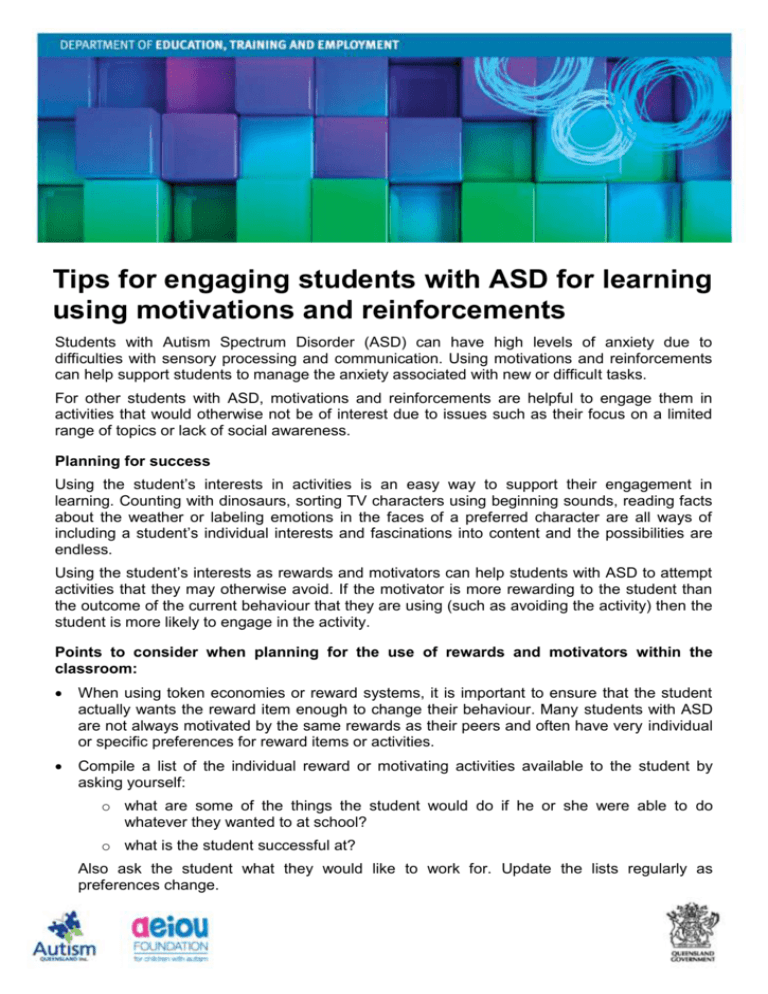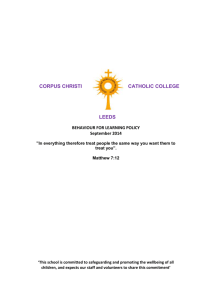Tips for engaging students with ASD for learning: Using Motivation
advertisement

Tips for engaging students with ASD for learning using motivations and reinforcements Students with Autism Spectrum Disorder (ASD) can have high levels of anxiety due to difficulties with sensory processing and communication. Using motivations and reinforcements can help support students to manage the anxiety associated with new or difficult tasks. For other students with ASD, motivations and reinforcements are helpful to engage them in activities that would otherwise not be of interest due to issues such as their focus on a limited range of topics or lack of social awareness. Planning for success Using the student’s interests in activities is an easy way to support their engagement in learning. Counting with dinosaurs, sorting TV characters using beginning sounds, reading facts about the weather or labeling emotions in the faces of a preferred character are all ways of including a student’s individual interests and fascinations into content and the possibilities are endless. Using the student’s interests as rewards and motivators can help students with ASD to attempt activities that they may otherwise avoid. If the motivator is more rewarding to the student than the outcome of the current behaviour that they are using (such as avoiding the activity) then the student is more likely to engage in the activity. Points to consider when planning for the use of rewards and motivators within the classroom: When using token economies or reward systems, it is important to ensure that the student actually wants the reward item enough to change their behaviour. Many students with ASD are not always motivated by the same rewards as their peers and often have very individual or specific preferences for reward items or activities. Compile a list of the individual reward or motivating activities available to the student by asking yourself: o what are some of the things the student would do if he or she were able to do whatever they wanted to at school? o what is the student successful at? Also ask the student what they would like to work for. Update the lists regularly as preferences change. Rewards or motivating activities do not have to be of monetary value or a ‘treat’. Would the student enjoy time alone with his or her interests or being able to go outside early for play? Plan for success. Initially provide the reward to the student for work that you already have seen them easily achieve (e.g. complexity or length of time). Then progressively increase the expectations (eg. increase the length of time before gaining access to the reward; increase the complexity of demands; decrease the amount of time the student has access to the reward; include peers). When introducing a token reward system or a motivating activity into the student’s schedule, remember you may need to teach the student how the system or sequence works. That is they may not realise that they need to complete handwriting first (non-preferred task) then they may choose their book (motivating task). Use visual representations to support comprehension. Carefully observe and consider how long the student is able to sustain engagement at the moment and plan your teaching sequence around this. How many activities can the student complete before they will need access to a motivating, strengths-based, or calming activity? How long can they sustain the desired behaviour without any break or reward? Make it clear to the student what the actual desired behaviour is, such as ‘quiet mouth’, ‘hands and feet to yourself’ or two jobs completed. Ensure that it is obvious to the student just how much of the desired behaviour they must demonstrate before gaining the reward or motivating activity (e.g. 10 computer images to tick for quiet work = computer; maths, reading groups, THEN choose your book; work quietly until the bell goes). Many students with ASD do not easily comprehend how good is ’good enough’ to receive a reward or access to a preferred activity for ’being good’. Manipulate the density of reinforcement as necessary. That is, increase rewards and access to motivating activities when it appears the student requires extra motivation to sustain a desired behaviour and progressively extend work periods or expectations as the student becomes more successful. Stay calm. If the student becomes overly anxious and upset, it may be useful to have a break and plan to try again later to ensure the interaction ends well. Use peers and others as models. Use another student or adult to demonstrate completing the tasks and then gaining access to the motivating activity. Ensure you consider and plan for what will happen should the student refuse to complete the desired behaviour. That is, if you suggest that the student will gain access to the playground if they pack away an activity, then this will not work if the student is likely to gain access anyway. If this occurs, go back and renegotiate the reward. Consider your language. Make the spoken rules about rewards as simple as possible. Even with students who are using verbal language regularly, say “Maths first, then choose book” rather than “When you’ve finished all that maths, then you can go and look at the book shelf and choose your animals book”. Be very specific about the praise you provide so the student knows exactly what it is they have done well, for example “good sitting” or “good quiet working” is more specific than “good boy”. Consider how to include social reinforcements in the student’s day. Pair rewards with social comments and actions or look for interactions which are motivating to the student (jokes, routines with a specific person, an adult helping with a motivating task or a high 5). This builds rapport (increasing motivation) and supports the student to develop motivation for increased social engagement. Choose behaviours to be addressed wisely. Does the behaviour harm anyone? What might replace this behaviour? What skills does the student need to learn? What changes can I make to the learning environment to increase the likelihood of the desired behaviour occurring? Students who display behaviours that persistently interfere with learning may benefit from a more detailed investigation of the behaviour, triggers to the behaviour, environmental factors and skills to be learnt. Further information regarding this is available in the Positive behaviour support section.






